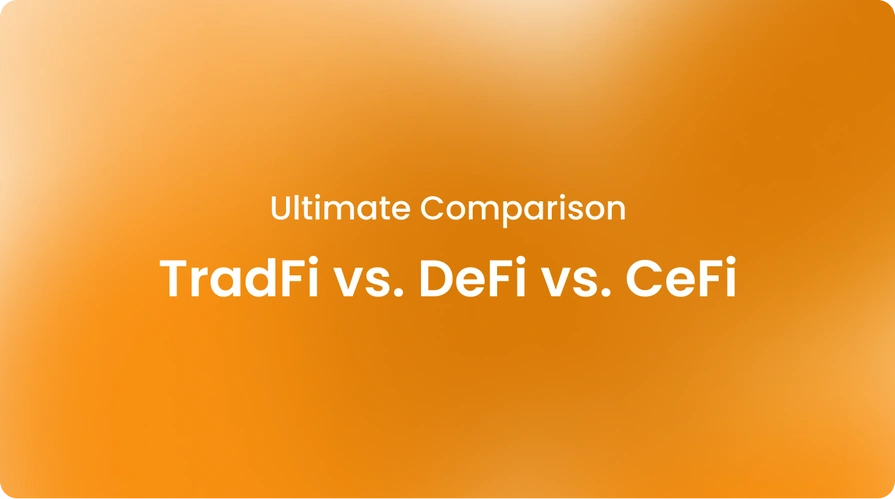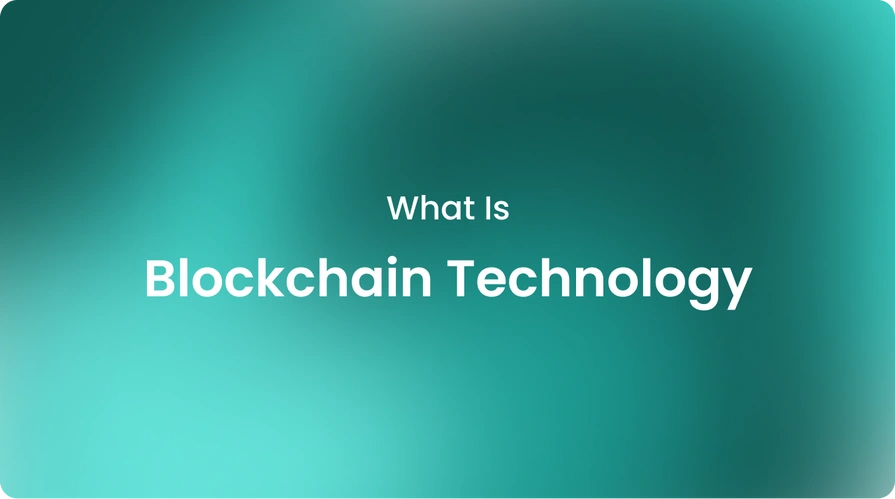|technology, knowledgehub
Ultimate Comparison: TradFi vs. DeFi vs. CeFi

The finance sector is ever-evolving, and the terms TradFi vs. DeFi vs. CeFi might seem complicated at first sight. We aim to explain each term in detail for you to understand thoroughly and decide which one is best for you.
In this blog, we will explore the major types of finance that currently exist—traditional finance (TradFi), decentralized finance (DeFi), and centralized finance (CeFi)—and compare what they offer as well as how they might develop together in the future.
DeFi is gaining popularity due to its transparency, reduced fees, and accessibility to anyone with an internet connection, challenging the dominance of TradFi and CeFi. Let's start by understanding TradFi first!
What is TradFi?
TradFi, or traditional finance, refers to the conventional financial system that has existed for decades. It involves trusted centralized intermediaries like banks, brokerages, and asset managers that facilitate transactions and hold custodial control over people's money and investments.
Around 85% of the global population currently interacts with TradFi through mechanisms like bank accounts, loans, credit cards, mortgages, and investment and retirement accounts.
How does TradFi work?
In TradFi, users must go through intermediaries to perform financial activities. For example, to obtain a loan, individuals must apply at a bank and undergo approval based on their credit history. The bank evaluates your risk and decides the terms.
Once approved, the bank holds your money in custody until you make payments. Investments also go through intermediaries; you give a brokerage firm money to purchase and manage assets on your behalf for a fee.
What is DeFi?
DeFi, or decentralized finance, aims to disintermediate TradFi by removing centralized intermediaries and instead having financial products built on public blockchains using smart contracts.
DeFi has the opportunity to fill gaps for the around 30% of people globally who are "unbanked" and lack access to TradFi services. DeFi stores transactions, records, and agreements digitally on blockchain public ledgers with no single point of control thanks to decentralization. Make sure to check out “DeFi Wallet.”.
How does DeFi work?
In DeFi, users interact directly with blockchain-based applications to borrow, lend, earn interest, and more. For example, on Aave, someone can deposit cryptocurrency they own into a "liquidity pool" smart contract and earn interest on those assets.
Others can then borrow directly from that pool by depositing collateral. Smart contracts automatically enforce the terms, such as liquidating collateral if the loan amount grows too large. No bank or company is involved—just public blockchain on-chain and off-chain transactions.
What is CeFi?
CeFi, or centralized finance, bridges some gaps between TradFi and DeFi. Like DeFi, CeFi involves digital financial services for crypto assets.
However, CeFi still relies on centralized intermediaries like crypto exchanges and platforms to hold custodial control over users' funds and handle back-end systems, unlike the fully decentralized nature of DeFi.
How does CeFi work?
In CeFi, companies offer TradFi-like services for cryptocurrencies. For example, crypto exchange platforms allow users to deposit crypto assets and earn interest. They pool and lend out these deposits to earn a yield. Some also offer crypto trading and lending functions.
However, funds are stored centrally on these companies’ platforms rather than on public blockchains, so they act similarly to traditional financial institutions rather than operating like truly decentralized DeFi protocols.
What are the main differences between TradFi, CeFi, and DeFi?
The main differences between TradFi, CeFi, and DeFi come down to levels of decentralization and control. Let's see these differences.
In TradFi, centralized intermediaries hold all control. In CeFi, intermediaries still control back-end systems and custody of funds. However, in DeFi, transactions are executed autonomously by code on public blockchains, without any single entity having control.
Additionally, TradFi focuses only on traditional assets, while CeFi and DeFi deal exclusively with digital currencies and crypto assets.
What are the main similarities between CeFi, TradFi, and DeFi?
Despite architectural differences, all three aim to provide similar financial services to some degree, including lending, borrowing, payments, savings, and investments. They also face similar regulatory uncertainties.
All involve digital records, and many also pursue similar goals of improving financial access, especially for the unbanked global population without traditional accounts.
Stablecoins, especially euro stablecoins such as EURK, also increasingly bridge between the models by allowing crypto holding while maintaining purchasing power parity with fiat currencies.
DeFi vs. CeFi
Companies handle funds and transactions differently. In CeFi, companies act as intermediaries and hold custody of user funds, just like in traditional finance.
However, in DeFi, users use non-custodial crypto wallets to maintain exclusive control over their private keys and funds, while executing transactions in a trustless and transparent manner on public blockchains.
DeFi protocols still have vulnerabilities, while CeFi provides user-friendly interfaces. Many see CeFi and DeFi converging in the future to balance decentralization with usability.
The risks of DeFi and CeFi
Both DeFi and CeFi entail risks due to their complexity and nascency. In DeFi, smart contracts could include bugs or exploits that impact users. Market volatility also increases liquidation in crypto and impermanent loss risks.
Meanwhile, CeFi is vulnerable if a central company suffers an operational or financial failure, as we saw with companies like Celsius and FTX. Proper due diligence on the part of project teams and a comprehensive understanding of protocols and platforms are important.
Regulations also present challenges as rules evolve. Diversification across domains mitigates any single point of failure risk. These are the main risks of DeFi and CeFi.
Is DeFi the future?
DeFi's growth in users and total value locked indicates it has proven durable and holds long-term promise by improving financial access globally.
But it also has further to go with user experience, regulatory clarity, and integration before replacing traditional banking. Many argue the future lies in a blended model where DeFi, TradFi, and CeFi aspects interact synergistically.
For example, Cryptobunq is a secure crypto service provider that allows TradFi companies to leverage crypto but also bridges TradFi and DeFi by enabling transactions with decentralized reliability and transparency.
Thanks to CBQ crypto and blockchain solutions, from tokenization to custody and wallet, you can leverage your crypto projects securely. If you want to explore more, make sure to check out CBQ blogs and case studies!
TradFi vs. CeFi vs. DeFi: What do they offer?
In TradFi vs. CeFi vs. DeFi differences, each has benefits. TradFi provides trusted brands with regulations but limited innovation. CeFi makes crypto easier via interfaces like exchanges but relies on central control. DeFi excels in transparency, programmability, and access for the unbanked, yet it has complexity.
Overall, the optimal system of the future may blend the strongest aspects—leverage smart contracts and decentralization where appropriate—but interface with traditional finance systems and provide consumer protections for widespread adoption.
By integrating with crypto services from Cryptobunq, you can empower the use of crypto benefits for your individual and business crypto needs.
How can TradFi, DeFi, and CeFi work together?
There are several synergies emerging. TradFi could provide fiat ramps and on/offboarding between crypto and traditional money. Stablecoins offer a transfer medium. CeFi and Defi could cooperate via decentralized exchange interfaces and regulated crypto custody services.
DeFi protocols could offer programmable smart contracts for TradFi workflows as projects. TradFi institutions may offer regulated blockchain nodes.
Greater interoperability through technologies and wormholes could foster extensible economies unconstrained by any single domain. The future likely involves elements of each area optimized through cooperation rather than competition. Crypto services from Cryptobunq also help with this cooperation.
How do you integrate TradFi, DeFi, and CeFi into your business?
Firms can pick aspects from each domain to suit their needs, perhaps using TradFi for fiat rails, smart contracts from DeFi for programmable workflows, and custodial services from CeFi. Experimenting on testnets first is wise.
The goal is to tap the strengths of each model: stability and regulations with TradFi, transparency and innovation with DeFi, and usability with CeFi.
Reputable partners who can securely offer the widest set of services, like crypto wallet capabilities, stablecoins, and more, from a single source make the process smoother. Integrating with a one-stop-shop crypto service provider like CBQprovides these advantages and simplifies participation.
The bottom line
The future of finance will likely involve elements of traditional centralized finance seamlessly interacting with innovative decentralized technologies and business models. Cooperation between domains is more constructive than competition.
Secure crypto services that cut across TradFi, DeFi, and CeFi, like those offered through Cryptobunq, promise to catalyze collaboration. By selecting the optimal aspects from each area, businesses can build the next era of inclusive, transparent, and accessible financial systems for all.
If you want your business to grow with the power of blockchain technology and adapt to the future of digital finance, you need a trusted partner, and CBQ is here to help. Contact us today and benefit from expert crypto solutions!













